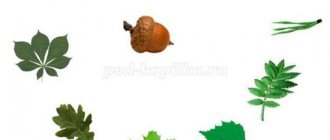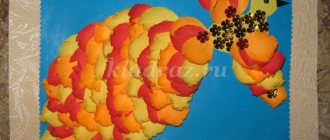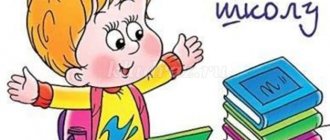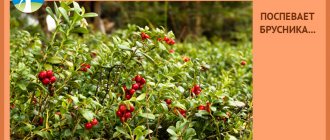Collection of games and exercises on the lexical topic “Trees in Autumn” Older age. - presentation
Collection of games and exercises on the lexical topic “Trees in Autumn” Older ages
Author of the presentation: Lomonosova Marina Anatolyevna Teacher-defectologist 2011
Contents: On a walk Let's think For the whole family Literary living room Interactive museum
On a walk You can carry out the games and observations presented in this section on the street while walking. They are aimed at enriching and clarifying children’s knowledge and ideas about trees in autumn, activating vocabulary, developing observation and attention, and correcting fine motor skills.
WALKING THROUGH THE AUTUMN PARK Walking through the autumn park, admire the beauty of the autumn landscape. Stop. Listen to the sounds of the autumn park. What sounds will you hear? And the child? Walk through the fallen leaves, listen to the rustling of the leaves. Create your own LEAF FALL while walking. Explain to your child the meaning of this word
LET'S TALK ABOUT TREES GOAL: To activate knowledge on the topic of “trees”. PRELIMINARY WORK: find one leaf each of maple, oak, rowan, a needle of spruce, and pine. PROGRESS OF THE CONVERSATION: Tell (and show) the child about the different parts of any tree (roots, trunk, branches, leaves). Talk about what each one is for. Find out what names of trees he knows. Show your child several different leaves and ask what tree they come from. Ask what changes happen to trees in the fall.
STUDYING TREE Trunks GOAL: To activate knowledge on the topic “trees”. PROGRESS OF THE CONVERSATION: Draw the child’s attention to the trunks of various trees. Ask your child what kind of trunk the tree has, what words can you use to describe it? The trunks can be THICK (try to clasp it with your hands together), or THIN. SMOOTH AND ROUGH - invite the child to touch them with his hands.
STUDYING TREE Trunks continued Taking a magnifying glass, examine the tree bark in detail. Invite your child to tell you what he sees. If you look at a cross section of a tree trunk or branch, you can easily see the so-called growth rings. Tell your child what you know about them.
ACTION WORDS GOAL: To train the child in selecting action words (verbs) PROGRESS OF THE GAME: Invite the child to select action words. Trees…..(sway, stand, make noise, grow). Leaves...(fall off, cover the ground, turn yellow, dry, wither, rustle).
ROLLING THE CONES NOTE: This game can be played outdoors and at home. PURPOSE: Self-massage of the palms to activate speech zones in the cerebral cortex. PRELIMINARY WORK: Try to find pine and fir cones. PROGRESS OF THE GAME: Invite the child to roll the fir cone first. Now offer pine. Ask your child which lump hurts the most.
LAYOUT BY SIZE NOTE: This game can be played both outside and at home at the table. GOAL: to continue to strengthen the skill of assembling a number of objects, taking into account their size PRELIMINARY WORK: It is necessary to collect several acorns, chestnuts, leaves of different sizes. PROGRESS OF THE GAME: Invite the child to first lay out the acorns from the largest to the smallest, and then vice versa. Suggest doing the same with chestnuts. You can also suggest laying out the leaves. Offer to count all the items.
BLOTTING ON A LEAF GOAL: Consolidating the skill of purposeful smooth exhalation. PROCEDURE OF THE GAME: Place a piece of paper on the child’s palm. Ask him to blow on the piece of paper so that it flies off his hand. Make sure that your child does not puff out his cheeks during the exercise.
AUTUMN BOUQUET Collect the leaves and place them under a press. When they are dry, they can be pasted into a diary or calendar and secured with transparent adhesive tape, or simply made into an autumn bouquet. This will be a wonderful memory of your autumn walk.
Let's think about it. The games presented in this section do not require additional preparation to play.
WHAT COLOUR? GOAL: Consolidating ideas about color in nature, developing visual perception, color discrimination. INSTRUCTIONS: Name the color of the leaves.
LOOK AND GUESS GOAL: Development and activation of visual attention, holistic perception of an object, visual memory INSTRUCTIONS: Look at the contours. Guess what the artist drew.
LOOKING FOR SHADOW GOAL: Development of concentration of visual attention INSTRUCTIONS: Find the shadow of each tree.
LOOKING FOR A SHADOW continued GOAL: Developing concentration of visual attention INSTRUCTIONS: Find the shadow for each leaf.
FIND THE EXTRA PICTURE GOAL: Development of mental operations of analysis, synthesis, generalization INSTRUCTIONS: Look carefully at the pictures. Name (show) the extra picture. Explain your choice
FIND THE EXTRA PICTURE**
COUPLE GOAL: Development of mental operations of comparison, analysis, visual attention. INSTRUCTIONS: Look at the picture. What trees are the leaves drawn from? Find and name two identical sheets.
FRUITS GOAL: Activation of the dictionary on the topic “Trees”, INSTRUCTIONS: Look at the pictures, name the fruits of the trees. What tree does each of these fruits come from?
TELL WHAT? GOAL: Practice selecting adjectives. PROCEDURE OF THE GAME: Ask the child which tree each of these leaves comes from. Sample conversation: -Which tree is the leaf from? -This is a leaf from an oak tree. - So what is he like? -Oak.
For the whole family The tasks posted here will require a little preliminary preparation, to which you can include all family members.
FUNNY CLOTHESPENS OBJECTIVES: Development of fine motor skills, color perception, imagination. PRELIMINARY WORK: Make a base for future work from thick cardboard. Show your imagination: the yellow circle is the basis for the sun, the triangle is the tree trunk, etc. PROCEDURE OF THE GAME: Ask your child to attach clothespins of the desired color to the base.
FIRE TREES IN A GLADE OBJECTIVES: Development of fine motor skills, consolidation of ideas about the geometric figure “triangle”, development of imagination PRELIMINARY WORK: Cut out several green triangles of different sizes. GAME PROCEDURE: Ask your child to collect a Christmas tree (or Christmas trees)
Literary living room This section contains literary material on the topic: riddles, proverbs, sayings,
PROVERBS AND SAYINGS Dry trees burn, but living trees bear fruit. Without wind, trees do not sway. Tall trees suffer more from the wind. Trees without fruit are planted, and then the fruit from them is eaten. See trees in their fruits, and see people in their deeds. As are the trees, so are the fruits. GOAL: activation of the dictionary, clarification of the meanings of words, development of understanding of the figurative meaning of words. PROGRESS OF THE CONVERSATION: Read the proverbs and sayings. Pick one to start. Explain to your child the meaning of each of the words used in the proverb. Try to explain its meaning to your child in your own words. Try to use this proverb in your speech over the next few days so that the child begins to better understand its figurative meaning. You can also work with other sayings.
RIDDLES GOAL: Development and activation of vocabulary, development of logical thinking, sense of language. INSTRUCTIONS: Let's try to solve the riddles together. STEPS OF WORKING ON THE RIDDLE: 1. Read the riddle. 2.Wait a little, maybe the child will guess what we are talking about, and then there will be no need to move on to the next taps. 3.If you couldn’t solve the riddle, click the mouse anywhere on the screen and the answer will appear. (REMEMBER – when you click the mouse again, a picture of the answer appears.) 4.Ask what words and expressions are incomprehensible to the child. Try to explain their meaning in your own words. 5. It is possible that the child will not talk about difficulties with understanding (“I understand everything”). In this case, explain those words and expressions that you think are difficult for the child. 6.If it’s still difficult for your child, click the mouse and a picture of the answer will appear. Name what is drawn. Read the riddle again along with the answer. 7. PRAISE YOUR CHILD
RIDDLES Gold coins fall from a branch (Autumn leaves) Autumn has come to visit us and brought with it... What? Say it at random! Well, of course... (Leaf fall)
RIDDLES You will always find her in the forest - Let's go for a walk and meet her. Stands prickly, like a hedgehog, in a summer dress in winter. (Spruce) I have longer needles than the Christmas tree. I'm growing very straight in height. (Pine)
Poems about autumn for reading and learning: 1.A. S. Pushkin “The sky was already breathing in autumn...” 2.A. K. Tolstoy “Autumn, our whole poor garden is crumbling…” 3.A. Pleshcheev “Autumn has come...” 4.E. Blaginina “Flying away, flying away...” 5.I. Tokmakova. Osinka 6.S. Marshak. October. 7.A. Ekimtsev “Old poplar at the porch..” 8.I. Semenov. Birch
Interactive Museum This section contains images of autumn landscapes by famous artists and provides methodological recommendations for viewing the paintings.
WALKING THROUGH THE HALLS The next slide is a video series of images of autumn paintings. To activate it, just click the mouse anywhere on the slide. As the film progresses, pay the child’s attention to how the mood conveyed in the paintings changes (images of early autumn reflect an upbeat, joyful mood, and late autumn evokes sadness, despondency, sadness)
“Golden Autumn”. Isaac Levitan
Look carefully at the picture: at the river, at the golden leaves of the birches, at the yellowed grass... What time of year is this? Why do you think the artist called the painting “Golden Autumn”? What signs of early autumn can be seen in the picture? What is shown in the picture on the left? What can you see in the distance? What is the brightest thing in the picture? What mood did the artist convey? How did you guess what exactly it is - the mood is reflected? How did the artist manage to do this? What do you think or remember when you look at this picture? Did you like the picture? What did you like about her?
"Autumn. Village by the stream." Savrasov Alexey Kondratievich
Look carefully at the picture. What do you see? What signs of autumn can be seen in the picture? If you were in the picture, would you feel cold or hot? Why do you think so? What is shown in the foreground of the picture? What can you see in the distance? Why do you think there is smoke coming from the chimney? Pay attention to the sky. What words can describe it? (big, gloomy, cold, etc.) Do you see the birds on it? What kind of birds do you think these are and where do they fly? What mood did the artist convey? How did the artist manage to do this? Did you like the painting?
LEARNING TO COMPARE Try to remember the title and author of the paintings. What picture can we say “Sunny, bright, juicy”, “Gloomy, windy”? Name the color of paints that artists use for their paintings? Compare how your mood changes when you look at one picture or another.
We hope that you spent time with your child with benefit and in a good mood!
Sources of information: BOOKS: Baryaeva L.B. Gavrilushkina Games and activities with natural and man-made materials, St. Petersburg, 2005 Kataeva A.A., Strebeleva E.A. Didactic games and exercises in teaching preschoolers. M, 2001 Pozhilenko E.A. The world around us. St. Petersburg 2004 INTERNET RESOURCES:
Educational story about leaf fall for preschool children aged 5-7 years
Autumn educational story for older preschoolers “Why do leaves fall from trees in autumn?”
with presentation Author: Chernichenko Matvey 6 years old, pupil of preparatory group No. 7 “Bells” Municipal educational institution “Bendery Kindergarten No. 9”, Bendery Head: Pavlova Vera Valerievna teacher of the group with TNR Municipal educational institution “Bendery Kindergarten No. 9”, Bendery Description: the story says about the natural phenomenon of leaf fall, its benefits and causes. The story is useful for educators to organize a conversation about leaf fall, and for parents to read to their children.
Age audience: preschoolers 5-7 years old Purpose: familiarization with the natural phenomenon of leaf fall and its causes Tasks: - expand knowledge about the natural phenomenon of leaf fall; - understand the causes of leaf fall in deciduous trees; - know about the benefits of fallen autumn leaves; - cultivate a love of nature and curiosity; — develop the vocabulary of preschoolers In one southern city there lived a boy who loved to ask adults questions. Every morning when he woke up, he always began with a new, interesting and educational question. “Mom, why is the wind blowing today, but yesterday the weather was calm and windless?” - asked the boy. “Son,” his mother answered him, “Let’s look in the encyclopedia about the wind, find out why it blows.” The boy’s mother was very educated and erudite, she knew how to answer her inquisitive son. One morning the boy looked out the window. Near his house there grew a birch tree with thin and long branches. More recently, the leaves on the birch tree were green, but Autumn came, the leaves began to turn from green to bright yellow. “Mom, look, soon the whole birch tree will become bright yellow, as if dressed in a golden outfit,” the boy said to his mother. “You’re right, son, with the arrival of Autumn all deciduous trees change their color from green to yellow, orange, red, brown,” his mother answered him (slide 1)
“Please tell me, mom, why is this happening?”
- the boy asked her. “Okay,” my mother answered, “We’ll go with you for a walk in the park and see how the color of the leaves of the trees has changed.” The boy quickly put on his jacket, trousers, hat, and shoes. He was interested to know why the leaves of trees turn different colors in the Autumn. Mom and boy went for a walk in the park. “You see, son,” said the mother, “This is your birch tree. Look, what color are the leaves on its top?” - Mom asked. The boy raised his head up and saw that at the top of the birch tree the leaves had become bright yellow, and below they were still green. “Mom, the leaves on top have already turned yellow, but below they are still green. Why is this happening?" - asked the boy. “It’s very simple,” my mother answered, “With the arrival of Autumn, all deciduous trees begin to prepare for the cold and winter. That's why they change the color of their leaves. In the summer there was a lot of light, warmth, the leaves were green, there was chlorophyll inside them, and with the onset of Autumn, chlorophyll ceases to be produced in the trees in the leaves, so they become colored yellow, red, orange or brown. Even with the onset of cold autumn days, the trees begin to shed their bright leaves. Remember what this natural phenomenon is called?” - Mom asked. “It’s leaf fall!” - the boy guessed. “So this is why the leaves of trees fall in the fall - the trees are preparing for the cold. Tell me, mom, why else do trees shed their leaves?” - asked the inquisitive boy (slide 2)
"Fine!"
- Mom answered, “All trees produce chlorophyll in their leaves in the summer, that’s why they are green. With the onset of Autumn, chlorophyll is not produced, the tree cannot eat as much as it did in the summer. Therefore, to reduce its nutrition, the tree sheds its leaves to the ground. Deciduous trees also sense the onset of cold days and the drop in air temperature at night very well. There are fewer and fewer leaves on the trees,” the mother continued the story. “Yes, I saw when I came to kindergarten that on our plot the maple leaves began to fall after a cold night, all the paths were covered with bright red and orange maple leaves,” said the boy (slide 3)
“Even when Autumn comes, a cold wind often blows, the leaves are damaged by insects, so the trees shed their foliage to the ground.
Also, inside the leaves the tree deposits harmful salts that the tree does not need, so with the fallen leaves the tree is cleansed of harmful and unnecessary salts,” the mother continued. “How interesting this is! Why are coniferous trees always green and do not change their color? Aren’t they afraid of the cold?” - asked the boy (slide 4)
“Nature came up with the idea that coniferous trees have needles instead of leaves.
They are covered with wax. Wax protects the needles from the cold, and the cells of the needles contain substances that prevent them from freezing even in severe frosts. The needles, of course, also fall off, but not all at once, like leaves on deciduous trees,” my mother answered. “Mom, is there any benefit from the leaves that have fallen from the trees?” - asked the boy. “Of course, son. In nature, everything is invented very wisely. In autumn, with the onset of cold weather, a tree prepares for winter sleep; it will wake up from this sleep with the onset of Spring, then new leaves will grow. Fallen leaves nourish the soil with their necessary substances. With the onset of Spring, trees will need these necessary substances to grow their new leaves. Foliage also protects trees from severe frosts and warms the soil and tree. When a tree sheds its leaves, it conserves water inside itself,” the mother finished the story (slide 5)
"Thank you mom!
I was interested to know that leaf fall is a very useful natural phenomenon that helps trees survive the winter,” the boy answered. The boy and his mother went to collect fallen autumn leaves in the park to make an autumn tree with fallen leaves at home (slide 6)
One inquisitive boy and his erudite mother had such an interesting and educational autumn walk
(slide 7)
Thank you for your attention!
Presentation on the topic: Educational story for preschoolers “Why do leaves fall from trees in autumn?”
We recommend watching:
A story about autumn for children of the second younger group A conversation “Colors of Autumn” in the preparatory group A story about September for older preschoolers A story about October for children 5-7 years old
Similar articles:
Poems about the seasons for preschoolers with pictures



